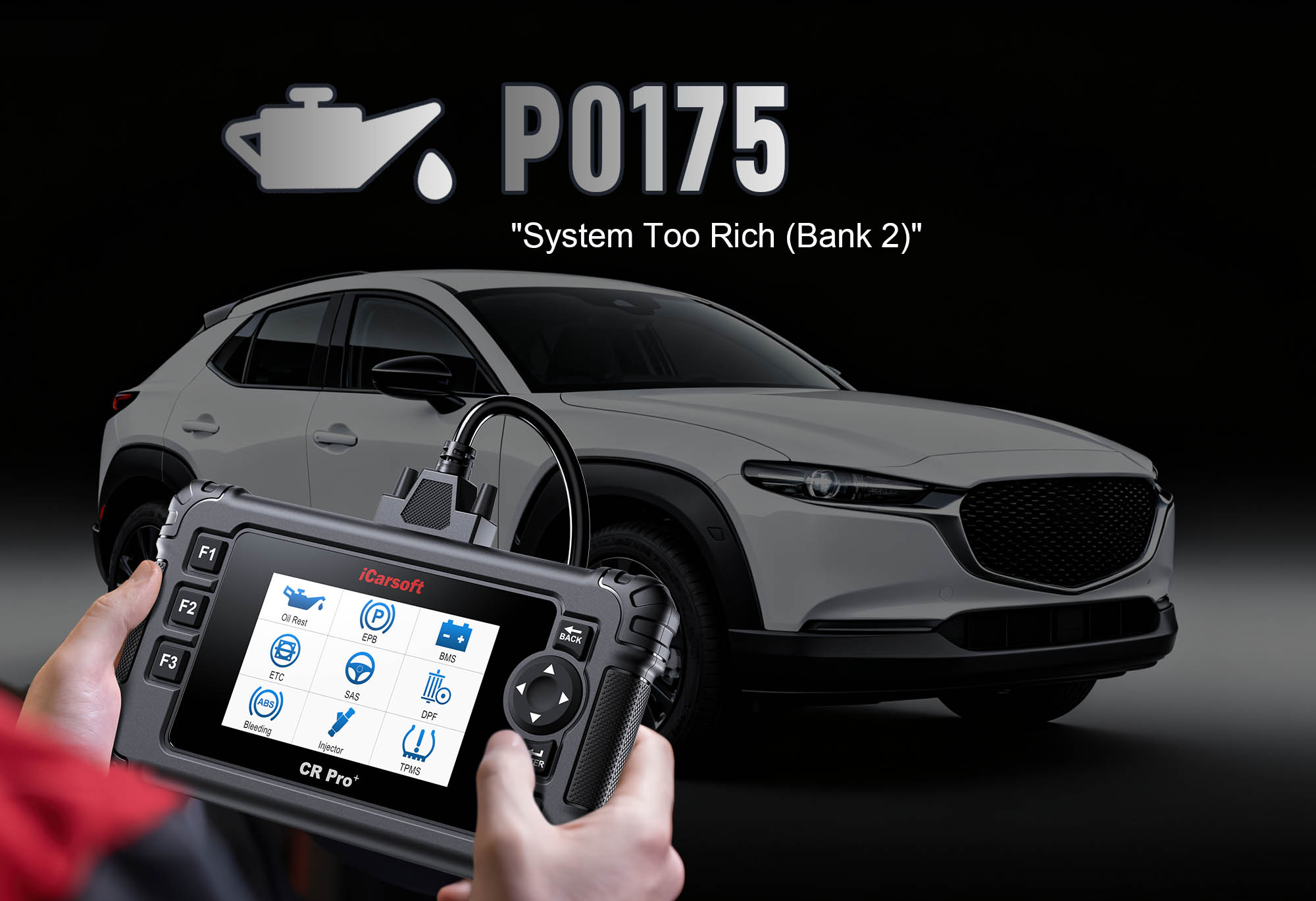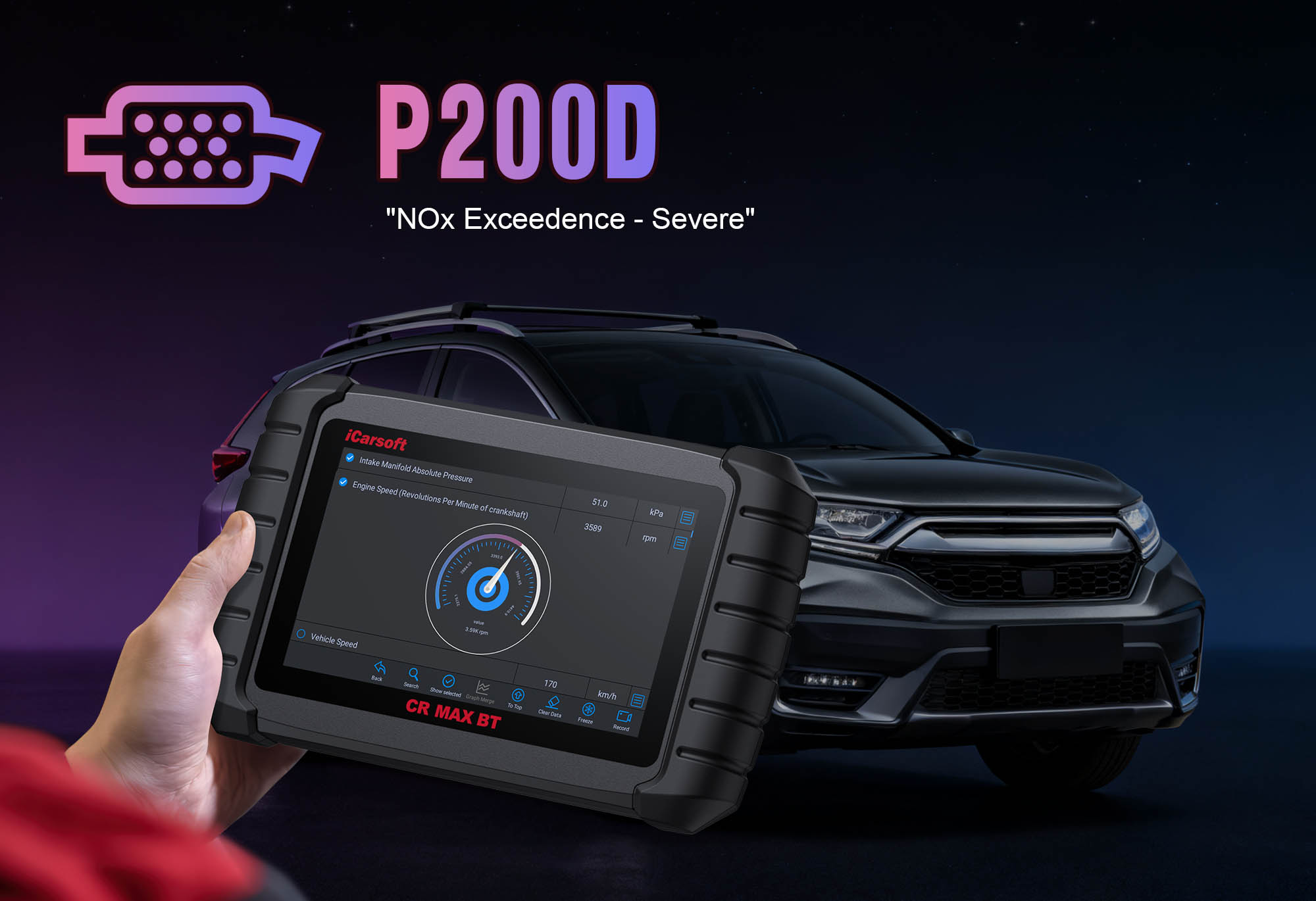Diagnose & Clear P0175 with iCarsoft CR Pro+: Fix Fuel System Too Rich (Bank 2)
If your check engine light illuminates and a scan returns P0175, your vehicle’s fuel delivery system is signaling an imbalance in the air-fuel mixture. This generic OBD-II code stands for "System Too Rich (Bank 2)"—meaning the Engine Control Module (ECM) has detected that the fuel mixture in Bank 2 is excessively rich (too much fuel relative to air), disrupting combustion efficiency.
Modern engines rely on a precise 14.7:1 air-fuel ratio for optimal performance. The ECM uses oxygen (O2) sensors and mass airflow (MAF) sensors to adjust fuel injection, ensuring this balance. When P0175 occurs, Bank 2 (a specific set of cylinders) receives more fuel than needed, leading to poor fuel economy, increased emissions, and potential damage to the catalytic converter.
Basic scanners might only confirm "rich mixture" but can’t isolate issues to Bank 2 or test components like fuel injectors. The iCarsoft CR Pro+—with its bank-specific fuel trim analysis, injector activation tests, and sensor data monitoring—solves this. Let’s walk through how to diagnose and resolve P0175.
 iCarsoft CR Pro+ displaying Bank 2 fuel trim and O2 sensor data for P0175 diagnosis
iCarsoft CR Pro+ displaying Bank 2 fuel trim and O2 sensor data for P0175 diagnosis
Understanding P0175: Causes & Key Symptoms
To tackle P0175 effectively, recognize how a rich mixture impacts Bank 2 and overall engine performance:
Key Symptoms of P0175
-
Check Engine Light: Illuminates when Bank 2’s long-term fuel trim (LTFT) stays below -10% (rich threshold) for multiple drive cycles.
-
Reduced Fuel Efficiency: Excess fuel wastes energy—expect 10–20% lower MPG (e.g., dropping from 30 MPG to 24 MPG).
-
Rough Idle: Unburned fuel in Bank 2 causes vibrations at idle, especially noticeable when stopped.
-
Strong Fuel Odor: Uncombusted fuel in exhaust creates a distinct gasoline smell, worse during startup.
-
Catalytic Converter Overheating: Unburned fuel ignites in the converter, risking damage (signaled by a hot, glowing exhaust).
-
Black Smoke from Exhaust: A telltale sign of rich combustion—sooty residue may coat the tailpipe.
Common Causes of P0175
|
Cause
|
Description
|
|
Leaking Fuel Injectors (Bank 2)
|
Stuck-open injectors deliver excess fuel to Bank 2 cylinders—directly disrupting the air-fuel ratio (accounts for ~40% of P0175 cases).
|
|
Faulty Oxygen Sensor (Bank 2, Sensor 1)
|
A worn upstream O2 sensor sends incorrect "lean" readings to the ECM, tricking it into over-fueling Bank 2 to "correct" the false imbalance.
|
|
Clogged Air Filter or Restricted Intake
|
Limited airflow to Bank 2 creates a rich mixture—same fuel volume with less air (common in vehicles with infrequent air filter changes).
|
|
Fuel Pressure Regulator Malfunction
|
A stuck regulator maintains high fuel pressure, forcing extra fuel into Bank 2 injectors regardless of ECM commands (seen in high-mileage vehicles).
|
|
Vacuum Leaks (Bank 1, Not Bank 2)
|
Leaks in Bank 1 cause the ECM to overcompensate by enriching the entire fuel system—disproportionately affecting Bank 2’s mixture.
|
|
MAF Sensor Contamination
|
A dirty MAF sensor underreports airflow to the ECM, leading it to add unnecessary fuel to Bank 2 (and potentially Bank 1) to "balance" the ratio.
|
Why iCarsoft CR Pro+ Excels at Diagnosing P0175
The CR Pro+ outperforms basic tools with features tailored to bank-specific fuel system diagnostics—critical for pinpointing P0175’s root cause:
Bank-Specific Fuel Trim Analysis
Displays short-term (STFT) and long-term (LTFT) fuel trim for Bank 2, quantifying richness (e.g., LTFT = -15% confirms severe P0175).
Dual O2 Sensor Monitoring
Compares upstream (Bank 2, Sensor 1) and downstream (Bank 2, Sensor 2) O2 readings to isolate sensor vs. fuel delivery issues.
Fuel Injector Activation Tests
Bi-directionally controls Bank 2 injectors to detect leaks or sticking—no physical disassembly needed (hears "clicks" and monitors pressure).
Real-Time Fuel Pressure Tracking
Measures fuel pressure in real time to identify regulator faults—high pressure (>55 psi) confirms over-fueling as a P0175 trigger.
Vehicle-Specific Diagrams
Preloaded with Bank 2 cylinder layouts, injector locations, and sensor positions for 65+ makes (e.g., BMW 5 Series, Ford Mustang, Mercedes C-Class).
Post-Repair Verification
Runs fuel trim tests to confirm Bank 2 mixture is balanced (STFT/LTFT within ±5%)—ensures repairs resolve the root cause.
Step-by-Step: Diagnose P0175 with iCarsoft CR Pro+
-
1. Connect & Confirm the Code
Plug the CR Pro+ into your vehicle’s OBD-II port (under the dashboard) and power it on.
Select your vehicle via Auto VIN Scan (reads your VIN in 2 seconds) or manual entry (make/model/year/engine).
Navigate to Engine > Fault Codes > Read Codes to confirm P0175. Tap Code Details for vehicle-specific info (e.g., "BMW: Bank 2 LTFT = -17% – Excess Fuel Delivery").
-
2. Identify Bank 2 Cylinders
First, confirm which cylinders belong to Bank 2 using the CR Pro+:
Navigate to Component Location > Engine > Cylinder Banks.
The scanner displays:
For V-engines (V6, V8), Bank 2 = cylinders farthest from the front (e.g., V8: Bank 1 = 1-2-3-4, Bank 2 = 5-6-7-8).
For inline engines (4/6-cyl), Bank 2 only exists in rare dual-bank setups (e.g., some high-performance 4-cylinders like Subaru WRX or Volkswagen Golf R).
Mark Bank 2 cylinder locations with tape to focus inspections later.
-
3. Analyze Live Fuel Trim & O2 Sensor Data
The CR Pro+’s real-time data pinpoints the source of richness:
Start the engine and let it reach operating temperature (10–15 minutes, coolant temp ≥180°F).
Navigate to Engine > Live Data > Fuel System and select Bank 2 parameters:
"Short-Term Fuel Trim (STFT)": Should fluctuate between -5% and +5%. Persistent values < -10% = active rich condition.
"Long-Term Fuel Trim (LTFT)": Should stay between -10% and +10%. Values < -10% = chronic richness (ECM can’t correct).
"Upstream O2 Sensor Voltage (Bank 2, Sensor 1)": Normal = 0.1–0.9V (rapid fluctuations). Steady high voltage (>0.8V) = rich exhaust.
Compare Bank 2 to Bank 1 (if applicable):
Only Bank 2 is rich = issue isolated to Bank 2 components (injectors, O2 sensor).
Both banks rich = systemic problem (fuel pressure, MAF sensor).
-
4. Inspect Bank 2 Fuel Injectors for Leaks
Leaking injectors are a top cause of P0175—test with the CR Pro+:
Leak Test:
Navigate to Special Functions > Fuel System > Injector Leak Test.
The scanner closes all injectors and monitors fuel rail pressure. A drop >5 psi in 5 minutes = leaking injector (focus repairs on Bank 2).
Activation Test:
Select Injector Activation and test each Bank 2 injector individually (e.g., Cylinder 5, 6, 7, 8 for V8 Bank 2).
Listen for a crisp "click" (proper valve operation). Muffled/no click = stuck injector (clean with specialized cleaner or replace).
Cleaning (If Needed):
Use the CR Pro+’s Injector Clean Guide to select a compatible cleaner (e.g., Liqui Moly Jectron) and follow the "direct injection" or "port injection" procedure—run the engine at 2000 RPM for 10 minutes to circulate cleaner.
-
5. Test the Bank 2 Upstream O2 Sensor
A faulty O2 sensor misleads the ECM—verify with the CR Pro+:
Response Test:
Go to Special Functions > Sensors > O2 Sensor Response.
The scanner checks how quickly the Bank 2, Sensor 1 switches between lean (0.1V) and rich (0.9V) when revving the engine. Slow response (>1 second) = worn sensor (replace with OEM part).
Heater Circuit Check:
Navigate to O2 Sensor Heater Test to ensure the sensor’s heater element works. No voltage reading (0V) = heater failure (causes inaccurate readings—replace sensor).
Visual Inspection:
Locate the sensor using the CR Pro+’s component diagram (typically on the Bank 2 exhaust manifold), disconnect the wiring harness, and remove it with an O2 sensor socket.
Check for contamination:
- Black soot = rich mixture (confirms P0175).
- White/grey deposits = coolant/oil leak (fix leaks before replacing the sensor).
-
6. Check Fuel Pressure & Regulator
High fuel pressure forces excess fuel into Bank 2—diagnose with the CR Pro+:
Connect a fuel pressure gauge to the Schrader valve (use the CR Pro+’s diagram to locate it—usually on the fuel rail near Bank 2).
Navigate to Engine > Live Data > Fuel System > Fuel Pressure.
Normal pressure = 35–50 psi (varies by vehicle—check CR Pro+’s "Specs" tab for your make/model).
Values >55 psi = faulty fuel pressure regulator (replace it to reduce pressure—e.g., Delphi FG1083 for GM vehicles or Bosch 0280160501 for European models).
-
7. Inspect Air Intake & MAF Sensor
Restricted airflow creates a rich mixture—check with the CR Pro+:
Air Filter Check:
Locate the air filter box via the CR Pro+’s diagram (near the front of the engine bay). Open the box and inspect the filter—dirty/debris-covered filter = replace (use OEM or high-quality aftermarket filters).
MAF Sensor Test:
Go to Special Functions > Sensors > MAF Validation.
The scanner compares actual airflow (g/s) to expected values at idle (normal = 3–7 g/s) and 2000 RPM (normal = 15–25 g/s). Low readings = dirty sensor.
Clean the MAF sensor with specialized MAF cleaner (avoid touching the delicate sensor element with fingers)—spray lightly, let dry for 10 minutes, then reinstall and retest.
-
8. Check for Vacuum Leaks (Bank 1)
Leaks in Bank 1 can cause P0175 by tricking the ECM into over-fueling—test with the CR Pro+:
Navigate to Engine > Live Data > Intake System > Manifold Absolute Pressure (MAP).
Monitor MAP at idle (normal = 30–40 kPa).
Spray a small amount of carburetor cleaner on Bank 1 intake hoses, gaskets, and throttle body connections.
A sudden drop in MAP (>5 kPa) = vacuum leak—repair with new hoses (e.g., silicone vacuum hoses) or gasket sealant (Permatex Ultra Black).
-
9. Repair & Clear P0175
Fix the root cause based on diagnostics—prioritize low-cost fixes first:
- Leaking Bank 2 Injectors: Replace with OEM injectors (use CR Pro+’s Part Lookup for compatibility—e.g., Denso 23250-0L010 for Toyota).
- Faulty O2 Sensor: Install a new Bank 2, Sensor 1 (match the sensor type—4-wire, 5-wire, or wideband).
- High Fuel Pressure: Replace the fuel pressure regulator (follow CR Pro+’s service manual steps for your vehicle).
- Dirty MAF/Air Filter: Clean/replace the MAF sensor and air filter.
- Bank 1 Vacuum Leaks: Repair with new hoses or gaskets.
Clear the code: Navigate to Engine > Fault Codes > Clear Codes to delete P0175 and any related fuel system faults.
-
10. Verify the Repair
Confirm Bank 2 mixture is balanced to avoid P0175 recurrence:
Recheck Live Data: Bank 2 STFT/LTFT = -5% to +5%; upstream O2 sensor voltage fluctuates 0.1–0.9V; fuel pressure = 35–50 psi.
Test Drive: Take a 30-minute test drive (include city stop-and-go and highway speeds) to check for rough idle, fuel odor, or black smoke.
Re-scan: Connect the CR Pro+ again and run a fault code scan—no P0175 + improved fuel efficiency (10–20% MPG increase) = successful repair.
Emissions Readiness: Navigate to Readiness Monitors to ensure the "Fuel System" and "O2 Sensor" monitors are "Ready" for state emissions tests.
Preventing P0175 Recurrence
The CR Pro+ helps maintain a balanced fuel mixture long-term, avoiding future P0175 codes:
-
Injector Maintenance: Use the CR Pro+’s Service Reminder to clean Bank 2 injectors every 15,000 miles (use fuel system cleaner with PEA additive).
-
O2 Sensor Replacement: Replace upstream O2 sensors (Bank 2, Sensor 1) every 60,000–100,000 miles (set a reminder in the CR Pro+).
-
Air Filter Checks: Inspect the air filter monthly via the CR Pro+’s "Maintenance Log"—replace when dirty.
-
Fuel Quality: Use Top Tier gasoline to reduce injector clogs and sensor contamination (the CR Pro+ can log fuel type in the "Vehicle Notes" tab).
-
Vacuum System Inspections: Check Bank 1/Bank 2 vacuum hoses during oil changes—replace brittle/cracked hoses before leaks occur.
Conclusion
P0175’s focus on Bank 2 richness makes it a precise yet critical fault, but the iCarsoft CR Pro+ simplifies diagnosis with bank-specific tools. Unlike basic scanners that only label the code, the CR Pro+ lets you isolate issues to Bank 2 components, test injectors/sensors in real time, and verify repairs—ensuring you fix the root cause, not just the symptom.
Whether you’re replacing injectors, cleaning the MAF sensor, or adjusting fuel pressure, the CR Pro+ guides every step—restoring fuel efficiency, reducing emissions, and protecting your catalytic converter from damage. With this guide, you’ll turn a "rich Bank 2 mixture" fault into a straightforward DIY repair, saving time and avoiding costly mechanic fees.
FAQs About P0175 Code
Q: Can I drive my vehicle with P0175?
A: Yes, but only short-term. P0175 reduces fuel efficiency and risks catalytic converter damage (from unburned fuel igniting inside). Avoid long drives and fix the issue within 1–2 weeks to prevent costly repairs.
Q: Why does P0175 only affect Bank 2, not Bank 1?
A: P0175 is Bank 2-specific because the issue is isolated to that bank’s components—most commonly leaking injectors, a faulty upstream O2 sensor, or restricted airflow to Bank 2. Systemic issues (e.g., fuel pressure) would affect both banks.
Q: How much does it cost to fix P0175?
A: Costs vary by cause: O2 sensor replacement = $70–$150 (DIY); fuel injectors = $150–$400 (4 injectors, DIY); fuel pressure regulator = $50–$120 (DIY); MAF sensor = $80–$200 (DIY). Professional labor adds $100–$300—save by diagnosing with the CR Pro+ first.
Q: Will cleaning the MAF sensor fix P0175?
A: It depends—if the MAF sensor is contaminated and underreporting airflow (causing the ECM to over-fuel Bank 2), cleaning it may resolve P0175. Use the CR Pro+’s MAF Validation test to confirm: if actual airflow is 20%+ below expected, cleaning/replacing the MAF is likely needed.

 iCarsoft CR Pro+ displaying Bank 2 fuel trim and O2 sensor data for P0175 diagnosis
iCarsoft CR Pro+ displaying Bank 2 fuel trim and O2 sensor data for P0175 diagnosis



